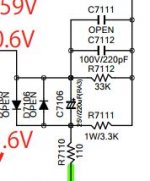This strange feedback appears to be in all current Denon and Marantz AVRs. The earliest model I found was the AVR-X 2000.
The gain is set by R7111 and R7110 at 3300/110 +1 = 33. The 220µ cap C7106 then feeds the AC signal to the base of the inverting input transistor (the diodes are not populated in any of the schematics I looked at), whereas R71112 (33k) provides a DC feedback, which has a HF bypass of 220p (C7112).
The older and higher end AVR4520 uses the classic circuit, i.e. 33K/1.2K divider with a 470 µ cap to ground. There is a similar cap (which is not populated) going from the negativ input to the output of the VAS but it is not populated.
The older circuit has 10x higher divider impedance and 2x the DC blocking capacitance, resulting in a corner frequency of 0.28 Hz. In spite of its higher impedance, it does not seem to need compensation in the feedback network (however, it uses an LTP mirror and classic VAS with CC load).
The newer circuit has a corner frequency of 6.5 Hz, and despite its lower feedback impedance, seems to need feedback compensation (these amps always have no LTP current mirror, up to AVR-X2x00, they use a bootstrapped VAS, from the AVR-X3x00/SR60xx they use a cascaded LTP with current mirror load).
Why use the extra resistor and compensation cap?
The gain is set by R7111 and R7110 at 3300/110 +1 = 33. The 220µ cap C7106 then feeds the AC signal to the base of the inverting input transistor (the diodes are not populated in any of the schematics I looked at), whereas R71112 (33k) provides a DC feedback, which has a HF bypass of 220p (C7112).
The older and higher end AVR4520 uses the classic circuit, i.e. 33K/1.2K divider with a 470 µ cap to ground. There is a similar cap (which is not populated) going from the negativ input to the output of the VAS but it is not populated.
The older circuit has 10x higher divider impedance and 2x the DC blocking capacitance, resulting in a corner frequency of 0.28 Hz. In spite of its higher impedance, it does not seem to need compensation in the feedback network (however, it uses an LTP mirror and classic VAS with CC load).
The newer circuit has a corner frequency of 6.5 Hz, and despite its lower feedback impedance, seems to need feedback compensation (these amps always have no LTP current mirror, up to AVR-X2x00, they use a bootstrapped VAS, from the AVR-X3x00/SR60xx they use a cascaded LTP with current mirror load).
Why use the extra resistor and compensation cap?
Attachments
Last edited:
Capslock
This global feedback is not new and was used in some older Sony amplifier from SE serie(see Sony_TA-N77ES service manual). I believe it was introduced by the Japanese brand Luxman that called it dual feedback or dual Betha or something like that.
I like this arrangement mainly with jFET as main differential pair.
This global feedback is not new and was used in some older Sony amplifier from SE serie(see Sony_TA-N77ES service manual). I believe it was introduced by the Japanese brand Luxman that called it dual feedback or dual Betha or something like that.
I like this arrangement mainly with jFET as main differential pair.
Last edited:
Ok, I'm getting it. The transistor input is essentially open circuit, so the capacitor is in series with R7112 and R7110, so much lower corner frequency. Even with 2.2 µ (MKT), one would still get 2.1 Hz. Neat!
The compensation cap C7111 is essentially in parallel to R7112 and R7111 because C7106 is an AC short which I also didn't realize at first. That makes for a much less radical phase correction.
The compensation cap C7111 is essentially in parallel to R7112 and R7111 because C7106 is an AC short which I also didn't realize at first. That makes for a much less radical phase correction.
- Status
- This old topic is closed. If you want to reopen this topic, contact a moderator using the "Report Post" button.
- Home
- Amplifiers
- Solid State
- strange Denon / Marantz power amp feedback circuit
